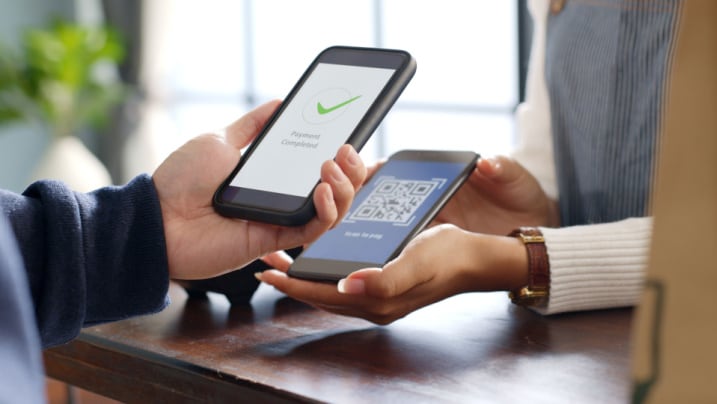CKYC Registry
-
Customer Service Contact us Service request Locate a branch
Find all the help you need
Scan the QR, get our app, and find help on your fingertips

Help CenterSupport topics, Contact us, FAQs and more
-
Login
Are you ready for an upgrade?
Login to the new experience with best features and services
-
Login
Are you ready for an upgrade?
Login to the new experience with best features and services
- Accounts
-
Deposits
IDFC FIRST Bank Deposits
View all Deposits -
Loans
IDFC FIRST Bank Loans
View all Loans - Wealth & Insure
-
Payments
IDFC FIRST Bank Payments
View all Payments -
Cards
IDFC FIRST Bank Cards
View all Cards - Blogs
- Corporate Account
-
Cash Management Services
IDFC FIRST Bank Cash Management Services
View all Cash Management Services - Supply Chain Finance
-
Corporate Lending
IDFC FIRST Bank Lending
View all -
Treasury
IDFC FIRST Bank Treasury
See more details - NBFC Financing
Support topics, Contact us, FAQs and more
- IDFC FIRST Bank Accounts
-
Savings Account
-
Corporate Salary
Account -
Senior Citizens
Savings Account -
First Power
Account -
Current Account
-
NRI Savings
Account -
TASC Institutional
Account -
Savings Account
Interest Calculator
- IDFC FIRST Bank Deposits
-
Fixed Deposit
-
Recurring Deposit
-
NRI Fixed Deposit
-
Safe Deposit Locker
-
FD Calculator
-
RD Calculator
- IDFC FIRST Bank Loans
-
Personal Loan
-
Consumer Durable
Loan -
Home Loan
-
Business Loan
-
Professional Loan
-
Education Loan
-
New Car Loan
-
Pre-owned Car Loan
-
Two Wheeler Loan
-
Pre-owned Two
Wheeler Loan -
Commercial Vehicle
Loan -
Gold Loan
-
Loan Against Property
-
Loan Against Securities
-
Easy Buy EMI card
-
Personal Loan
EMI Calculator -
Education Loan
EMI Calculator -
Home Loan
EMI Calculator
- IDFC FIRST Bank Wealth & Insure
-
FIRST Select
-
FIRST Wealth
-
FIRST Private
-
Mutual Funds
-
Sovereign Gold Bond
-
Demat Account
-
Term Insurance
-
Life Insurance
-
Health Insurance
-
General Insurance
-
Bonds
-
Loan Against
Securities -
Portfolio Management
Service
- IDFC FIRST Bank Payments
-
FASTag
-
Credit Card
Bill Payments -
UPI
-
Funds Transfer
-
Forex Services
-
Pay Loan EMI
- IDFC FIRST Bank Cards
-
Ashva :
Metal Credit Card -
Mayura :
Metal Credit Card -
FIRST Millennia
Credit Card -
FIRST Classic
Credit Card -
FIRST Select
Credit Card -
FIRST Wealth
Credit Card -
FIRST WOW!
Credit Card -
Deals
-
Debit Cards
-
Co-branded Cards
-
Credit Card
EMI Calculator -
FIRST Corporate
Credit Card -
FIRST Purchase
Credit Card -
FIRST Business
Credit Card
- Premium Metal Credit Cards
-
AshvaLifestyle1% Forex₹2,999
-
MayuraLifestyleZero Forex₹5,999
-
FIRST PrivateInvite Only
- Best for travellers
-
MayuraZero ForexMetal₹5,999
-
Ashva1% ForexMetal₹2,999
-
FIRST WOW!Zero ForexTravelLifetime Free
-
FIRST SWYPTravel OffersEMI₹499
-
FIRST Select1.99% ForexLifestyleLifetime Free
-
FIRST Wealth1.5% ForexLifestyleLifetime Free
-
Club VistaraTravelLifestyle₹4,999
-
IndiGo IDFC FIRST Dual Credit CardTravelLifestyle₹4,999
- Max benefits, Free for life
-
FIRST Classic10X RewardsShoppingNever Expiring Rewards
-
FIRST Millennia10X RewardsShoppingNever Expiring Rewards
-
FIRST Select10X RewardsLifestyle1.99% Forex
-
FIRST Wealth10X RewardsLifestyle1.5% Forex
-
FIRST WOW!RewardsTravelZero Forex
-
LIC ClassicRewardsInsuranceShopping
-
LIC SelectRewardsInsuranceShopping
- Reward Multipliers
-
AshvaLifestyleMetal₹2,999
-
MayuraLifestyleZero Forex₹5,999
-
FIRST ClassicNever Expiring RewardsShoppingLifetime Free
-
FIRST MillenniaNever Expiring RewardsShoppingLifetime Free
-
FIRST SelectNever Expiring RewardsLifestyleLifetime Free
-
FIRST WealthNever Expiring RewardsLifestyleLifetime Free
- Rewards & Credit on UPI
-
FIRST Power+FuelUPI₹499
-
FIRST PowerFuelUPI₹199
-
FIRST EA₹NVirtual1% Cashback₹499
-
FIRST DigitalVirtualUPI₹199
-
IndiGo IDFC FIRST Dual Credit CardUPITravelDual cards
- Fuel and Savings
-
FIRST PowerRewardsUPI₹199
-
FIRST Power+RewardsUPI₹499
-
LIC ClassicRewardsInsuranceShopping
-
LIC SelectRewardsInsuranceShopping
- Express and Flaunt
-
AshvaMetal1% Forex₹2,999
-
MayuraMetalZero Forex₹5,999
-
FIRST SWYPEMIOfferMAX₹499
-
FIRST MillenniaRewardsShoppingLifetime Free
- FD Backed rewarding Credit Cards for all
-
FIRST EA₹NVirtualCashback₹499
-
FIRST WOW!Zero ForexTravelLifetime Free
-
CreditPro Balance TransferTransfer & SaveReduce InterestPay Smartly
- IDFC FIRST Bank NRI Forex Solutions
-
Send money to India-Wire transfer
-
Send money to India-Digitally
-
Send money abroad
-
Max Returns FD (INR)
- IDFC FIRST Bank MSME Accounts
-
Platinum Current
Account -
Gold
Current Account -
Silver Plus
Current Account -
Merchant Multiplier
Account -
Agri Multiplier
Account -
TASC Institutional
Account -
Dynamic Current
Account -
World business
Account -
First Startup
Current Account
- IDFC FIRST Bank Business Loans
-
Business Loan
-
Professional Loan
-
Loan Against Property
-
Business Loan for Women
-
Working Capital Loan
-
Construction Equipment Loan
-
Machinery Loan
-
Healthcare Equipment Loan
- IDFC FIRST Bank Business Solutions
-
Payment Solutions
-
Tax Payments
-
Doorstep Banking
-
Point of Sale (POS)
-
Escrow Accounts
-
NACH
-
Payment Gateway
-
UPI
-
Virtual Accounts
-
As per amendment in the Income Tax Rules, PAN or Aadhaar are to be mandatorily quoted for cash deposit or withdrawal aggregating to Rupees twenty lakhs or more in a FY. Please update your PAN or Aadhaar. Kindly reach out to the Bank’s contact center on 1800 10 888 or visit the nearest IDFC FIRST Bank branch for further queries.
-
-
Most Searched
Sorry!
We couldn’t find ‘’ in our website
Here is what you can do :
- Try checking the spelling and search
- Search from below suggestions instead
- Widen your search & try a more generic keyword
Suggested
Get a Credit Card
Enjoy Zero Charges on All Commonly Used Savings Account Services
Open Account Now
Finance
All you need to know about the UPI forecast for 2024
Summary: This article examines the rapid growth of the Unified Payments Interface (UPI) in India since its launch in 2016, forecasting its trajectory by 2024. By simplifying digital payments and bringing convenience to millions, UPI has revolutionised the payments landscape.

Unified Payments Interface or UPI has revolutionised digital payments in India since its launch in 2016. In just a few years, UPI payments have emerged as the most prominent payment platform in the country, facilitating millions of cashless transactions on a daily basis. Industry experts believe UPI is poised to accelerate India's financial inclusion goals and transform how people pay and get paid in the coming years. This article examines UPI's growth trajectory so far and outlines the future of UPI in India for 2024 based on inputs from key stakeholders in the digital payments space.
Rapid growth and adoption
Launched by the National Payments Corporation of India (NPCI), UPI allows users to instantly transfer money between bank accounts without entering account details. By linking multiple bank accounts to a single mobile application, UPI has simplified payments and brought the convenience of digital transactions to the masses. According to NPCI, there are over 300 million UPI users in India today transacting on applications like Google Pay, PhonePe, and Paytm. UPI transaction volumes have witnessed a steady rise — surpassing 10 billion monthly transactions, representing year-on-year growth of over 60%.
This scale of adoption is a testament to UPI's user-friendly interface and its ability to promote financial inclusion. By facilitating hassle-free money transfers via smartphones, UPI has brought millions of unbanked and underprivileged Indians into the formal financial system. Small merchants too have leveraged UPI to digitise receipts and enhance their business operations. The platform's reach now extends beyond metros to tier 2 and tier 3 cities and rural pockets of the country.
READ MORE
Expanding UPI's footprint
While UPI usage is growing rapidly among smartphone users, a significant portion of India's population still uses feature phones. To onboard this demographic and accelerate rural adoption of UPI, NPCI launched ‘UPI 123Pay’ and ‘UPI Lite’ services in 2021. These allow users to access basic UPI features like account registration, payments, and balance checks through SMS and IVRS. Mehul Mistry, Global Head of Strategy at Wibmo, a leading fintech player, believes these initiatives will boost UPI's rural penetration over the next year. "UPI 123Pay and UPI Lite services will play a crucial role in expanding adoption in semi-urban and rural areas where feature phones still hold prominence," he noted in an interview.
Cross-border transactions
Industry participants in India are now eyeing the opportunity for UPI to facilitate international money transfers. By 2024, prominent stakeholders foresee UPI-enabling transactions with countries that have large Indian populations like Singapore, UAE, and others. This would provide Indian laborers and students overseas with convenient access to funds and open up new streams of remittances back home. Experts suggest that this could significantly benefit the Indian economy as well.
Discussions are currently underway between NPCI International and counterpart entities globally to actualise the vision of cross-border transactions using UPI.
New avenues and use cases
To maintain its torrid growth trajectory, UPI stakeholders are exploring adjacent areas for expansion as well. These include facilitating online educational and medical payments, digital ticketing, utility bill settlements and more through partnerships with enterprises.
Scaling UPI infrastructure
As transaction volumes continue surging, it is imperative for NPCI and the participating banks to scale the underlying UPI infrastructure to ensure smooth processes and avoid congestion. Some of the key steps include augmenting the existing server capabilities, onboarding more financial entities, and strengthening cybersecurity protocols to support UPI's expanding user base.
Developer support and incentives
To encourage innovators and fintech players to build new services on UPI, NPCI could consider initiatives like hackathons, startup grants, and reduced UPI fees. This will help foster the ecosystem and drive the development of industry-specific UPI use cases across food delivery, e-commerce, and others.
UPI international standards compliance
For UPI to facilitate cross-border money flows, it must align with prevalent ISO 20022 messaging standards. Stringent validations are underway and once approved, this will ease UPI's integration with payment gateways globally and accelerate its global adoption trajectory.
Partnerships with non-bank entities
Leveraging newer entities like merchant aggregators, insurance firms, and mutual funds can open up ancillary revenue streams on UPI. Strategic partnerships will expand the merchant network and drive the platform's growth beyond core P2P/P2M payments.
Privacy and data governance standards
As transactions swell, user privacy and data protection become critical. NPCI needs compliance frameworks to ensure sensitive financial information is secured responsibly. Governance guidelines can help optimise big data analytics from transactions for industry-wide insights as well.
UPI services launched in France, Sri Lanka, & Mauritius
The UPI service was launched at the Eiffel Tower in Paris on February 2nd, making France the first European country to accept India’s mobile-based payment system. With this, Indian tourists at the Eiffel Tower can start scanning the QR code which is generated on the merchant’s website to initiate payments. The UPI service is soon expected to extend to other merchants in the tourism and retail space across France as well as other parts of Europe.
A week after this launch, Sri Lanka and Mauritius are the latest countries to follow France’s suit in enabling UPI, which means that Indians visiting both these countries will now be able to use UPI to complete payments. This move also facilitates seamless transactions for Sri Lankan and Mauritian nationals who travel to India.
Expanding avenues
The unified payments interface (UPI) ecosystem in India is continuously expanding its reach. RuPay credit cards are now usable through UPI. This allows customers to make payments for their credit card purchases as well as other transactions using UPI.
IDFC FIRST Bank Credit Card holders can link their cards to UPI by opting for the FIRST Digital RuPay Credit Card. This effectively allows users to make contactless payments at 60 million merchant stores by scanning QR codes. It offers 3X reward points for UPI transactions above ₹2,000 and 1x reward points for lower value payments.
The FIRST Digital RuPay credit card has a joining and annual fee of just ₹199 and is instantly issued in a digital format for conducting transactions on UPI. This integration of credit cards on UPI is set to enhance payment convenience for customers.
If 2024 forecasts hold true, India will be well on its way to realising an inclusive digital economy fuelled by ubiquitous UPI-driven transactions across all strata. Convenience, safety, and financial inclusion will converge as UPI transforms the lives of ordinary Indians in the coming years.
Disclaimer
The contents of this article/infographic/picture/video are meant solely for information purposes. The contents are generic in nature and for informational purposes only. It is not a substitute for specific advice in your own circumstances. The information is subject to updation, completion, revision, verification and amendment and the same may change materially. The information is not intended for distribution or use by any person in any jurisdiction where such distribution or use would be contrary to law or regulation or would subject IDFC FIRST Bank or its affiliates to any licensing or registration requirements. IDFC FIRST Bank shall not be responsible for any direct/indirect loss or liability incurred by the reader for taking any financial decisions based on the contents and information mentioned. Please consult your financial advisor before making any financial decision.
The features, benefits and offers mentioned in the article are applicable as on the day of publication of this blog and is subject to change without notice. The contents herein are also subject to other product specific terms and conditions and any third party terms and conditions, as applicable. Please refer our website www.idfcfirstbank.com for latest updates.






















